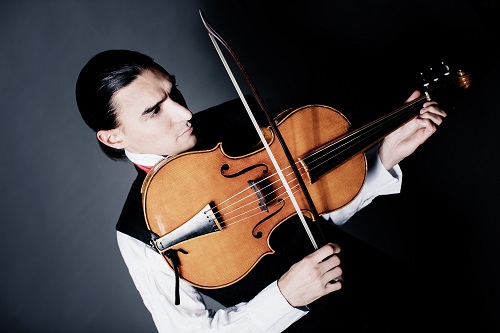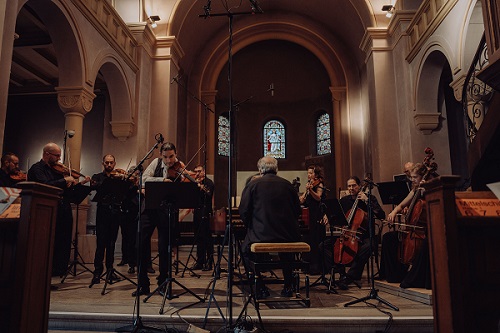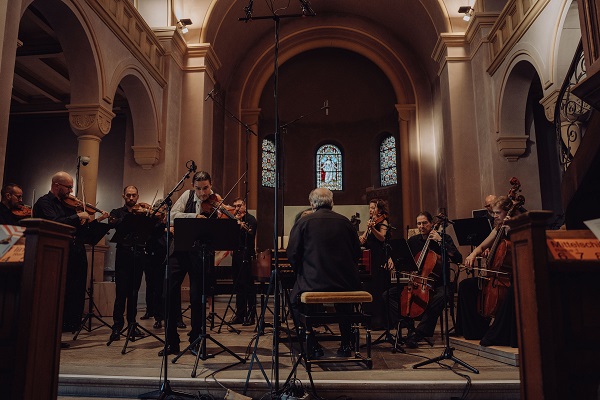 Germany Kissinger Sommer [2] – ‘Dueling Strings’: Sergey Malov (violin, violoncello da spalla), Venice Baroque Orchestra / Andrea Marcon (conductor). Erlöserkirche, Bad Kissingen, 30.06.2023. (LV)
Germany Kissinger Sommer [2] – ‘Dueling Strings’: Sergey Malov (violin, violoncello da spalla), Venice Baroque Orchestra / Andrea Marcon (conductor). Erlöserkirche, Bad Kissingen, 30.06.2023. (LV)

Vivaldi – Sinfonia in G major; Concerto in G minor for 2 cellos; Violin Concerto in D major, ‘Grosso Mogul’
Tartini – Violin Concerto in B-flat major; Cello Concerto in A major
Galuppi – Sinfonia in G major
On a Kissinger Sommer program titled ‘Dueling Strings’, Russian-Hungarian virtuoso Sergey Malov and the Venice Baroque Orchestra conducted by Andrea Marcon, its founder, gave a stunning demonstration of the violoncello da spalla, a musical griffin about 30 inches long with an extra fifth string tuned a fifth above the A string, and braced against the shoulder to play. It may have been the instrument on which Bach played, or imagined, his Sixth Solo Suite since it transforms the piece from a cellist’s nightmare into a relatively manageable beast.
Malov’s ‘da spalla’, as he refers to it in conversation, was built by the instrument’s premier luthier, Dmitry Badiarov. It spoke so easily and with such a beautiful voice that it slotted in perfectly between the violas and cellos. Malov’s standing as the instrument’s preeminent champion is reflected in the legend on his website logo which reads ‘Spallenmann’. If Haydn had known about the da spalla, he might have become the father of the string quintet.
The Orchestra opened the evening by scrunching deliciously into Vivaldi’s early Sinfonia in G major, revealing the full extent of the music’s magic, accented by an harmonic twist thrown off casually before the end. In the responsive acoustics of the Erlöserkirche, it could have been the soundtrack to an audiophile’s dream. The slow movement was shot through with the enchanting beauty of violins above throbbing pizzicato strings. In the finale, the orchestra let loose with marvelous torrents of sound played to a pulse of one to a bar.

Malov started with Tartini’s Violin Concerto in B-flat major, opening with a graceful flourish from Marcon at the harpsichord; the music’s rich interior colors and textures expanded Vivaldi’s epigrams into vast narratives, challenging the soloist to fit his responses into the music’s wit and virtuosity. Malov grasped the composer’s confounding universe and bravely confronted the mind-boggling difficulty of the solo part; he made the music seem so improvised that it was unclear at times which was Tartini and which was Malov. He spun the lovely, long-limbed Largo andante into what Tartini must have heard or imagined would be sung under a Tuscan Sun, and the brief postlude to the cadenza was spun gold. Marcon led his troops in elegant sweeping gestures through the finale, and the soloist’s success continued to be entirely wrapped up in theirs.
Malov, an energetic, magnetic performer and dressed as if he had stepped out of the eighteenth century, took off with madcap speeds and phrasing schemes in Vivaldi’s two-cello concerto and was matched in invention and virtuosity by Irene Liebau, the orchestra’s principal cellist. The slow movement was an almost promiscuously florid take on one of Vivaldi’s most inspired creations. It gave full voice to the da spalla’s rich overtones and stunning ability to project far beyond what the cello, even if played as magnificently as by Liebau, can achieve. Malov and Venice took the third movement at an even more insanely fast speed without losing the beauty of the song at its heart, the da spalla biting into the strings with vivid intensity; and hesitated with a unexpected pause of anticipatory silence before the two cellists launched into their final cadenzas.
The second half began with the open-hearted charms of Galuppi’s Sinfonia, reflected in the dreamy eyes of a young girl who leaned over the balcony enchanted by the music’s intricate decorations amidst their rustic delights. Malov wielded his da spalla again in the night’s second Tartini, a Cello Concerto in A major which was once more widely played than it is today. His curved bow encouraged him to make all sorts of extraordinary sounds no cello could ever dream of – his cadenza, accompanied by a cello drone in the orchestra, was like something out of the composer’s ‘Devil’s Trill Sonata’ infused with Indian sitar modes. Only in the finale did Tartini seem to get the better of the instrument and Malov.
Returning to the violin with some initial desperation, but followed impeccably and with ferocious intensity by the Orchestra, Malov took on Vivaldi’s extraordinary ‘Grosso Mogul’ concerto, using the composer’s long cadenzas full of wisps and runs and other flights of fancy as points of departure. The finale featured furiously bouncing bows in the violins and, after the concerto seemed to be over, Malov continued with yet another cadenza and the audience went wild. Malov played two encores, the rapid-fire last movement of ‘Summer’ from Vivaldi’s Four Seasons on the violin with breathtaking improvised riffs; and the Sarabande from Bach’s E-flat major Cello Suite on the da spalla, incomparably sad and beautiful.
To learn more about the violoncello da spalla, check out Dmitry Badiarov’s new book, Da Spalla: How Violinists Can Find Their Unique Voice and Open New Career Opportunities in 14 Days; and, with Raymond Aaron, last year’s On Fine Violin Making: From the Old Masters’ Legacy to the Future of the Craft.
Laurence Vittes

The Amazing beauty of words describing the beauty of music-making!
Bravo Laurence!